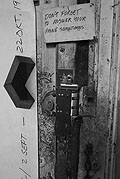| Richard Nonas (geb. 1936 in New York, lebt in New York) kam erst spät, Ende der 1960er Jahre, zur Kunst. Er studierte zuerst Anthropologie bei der berühmten, heute umstrittenen Margaret Mead, machte Feldarbeit bei Indianern in New Mexico und entspricht damit perfekt dem heutigen "Anforderungsprofil" bildender Künstler, die alles, nur nicht "nur" Künstler sein wollen. Dass er heute nicht einer der "Großen" ist, hängt auch mit seiner seit langem gepflegten altruistischen Haltung zusammen: die literarischen Hommagen an Person und Werk seines Künstlerfreundes Gordon Matta-Clark verstellen den Blick auf das eigene Werk. Dieses Künstlerbündnis ist mehr als Komplizenschaft und unkündbar. Dabei war Richard Nonas nicht nur bei der von Matta-Clark gegründeten Gruppe "anarchitecture" aktiv, er hatte damals auch ein beachtliches skulpturales Werk vorzuweisen. Die frühen Ankäufe durch Giuseppe Panza di Biumo für seine Sammlung, die Teilnahme an der documenta 1977 machten sein Werk im Rahmen der damaligen Möglichkeiten bekannt. Sein Interesse für Raum, der durch Skulptur fassbar wird, seine genau konstruierten environments, stellten Betrachter vor neue Wirklichkeitserfahrungen. Es ist eine Maßlosigkeit in diesem räumlich/skulpturalen Denken, es scheint, dass das einzige Maß darin ein Maß an Unendlichkeit ist. Diese Skulptur ist Raum, diese Skulptur ist eindeutig. Man fühlt, was ist. Dies die Möglichkeit zur Dechiffrierung.
In unserer Ausstellung cave kombiniert Richard Nonas Fotoaufnahmen seines Atelierraumes in New York mit Skulpturen aus ebendiesem Raum.
"The cut to home is what strong sculpture most shockingly is; the journey from looking-at to looking-into is what it most importantly accomplishes. Sculpture is the moving knife and not the cut the knife makes; the procession to and not the end reached.
This show is the itinerary of that."
Richard Nonas (2008)
"Richard Nonas is the most radical of all the minimalists I collected in the 'sixties and 'seventies.
……
When I first met Nonas in 1975 his means for making art was mainly a steel bar sheered off at both ends and placed diagonally at forty- five degrees. This was the only difference with respect to a similar bar fresh from the foundry. The greatest possible simplicity for any physically existing object, the final phase of reduction beyond which it is impossible to go.
It was this realization that fascinated me and aroused my interest in his work. To arrive at the starting point and the end of all things. Scientists are arduously and anxiously searching for the origin of everything, the algorithm with which the universe is constructed.
Nonas' sculptures were not just a physical but also a philosophical verification. Kant's Critique of Pure Reason applied to everything: in place of the primary forms of thought, the primary forms of reality. Beyond this there is only the noumenon, the unknown, what cannot be described. This is the final point of visibility. Nonas' steel rod, what we call material, is the last visible, but not invisible, point. …
Nonas has transformed [his] anthropological search for the primordial nature of human beings into his sculptures." (pp. 157-158)
"The maxim of simplicity and compositional rigor. It is difficult to go any further than this, the very limit of expressive possibility. I realize the dangers of this situation; on the other hand I am fascinated by the search for extreme limits. When you are near the limits, the presence of the unknown, the mystery of existence, whether ours or of everything, becomes evident. This unknown and mysterious presence is everywhere and in all things, the difficult thing is to know how to see it…. Art's greatest results are on the rare occasions when this presence becomes evident. This explains my preference for fifteenth century Italian and Flemish art. Another example would be the sculptures of Richard Nonas that are similar corrugated geometric forms, like the folds caused by the shifting of the earth's crust." (p. 303)
Giuseppe Panza, MEMORIES OF A COLLECTOR (Abbeville Press Publishers, New York and London, 2007) |

|




